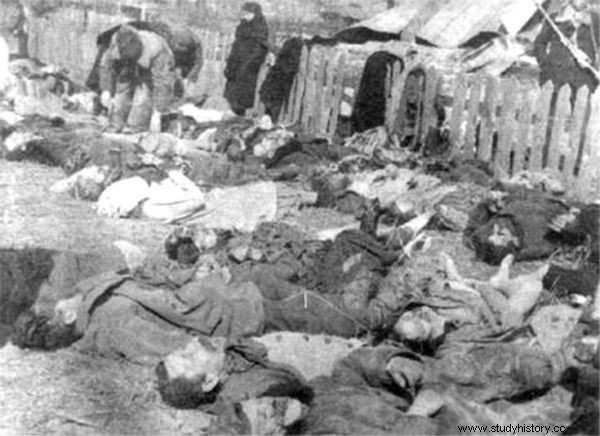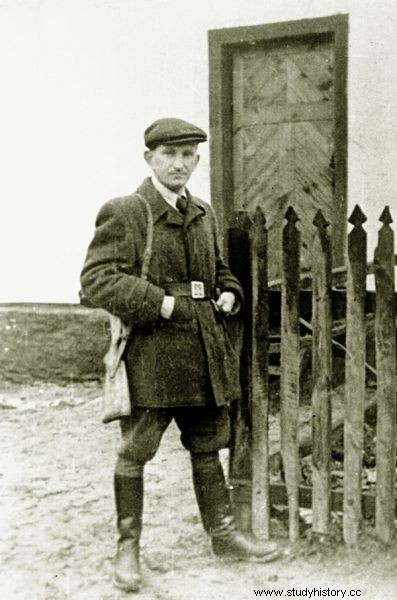We cannot talk about the Polish-Ukrainian conflict in the Borderlands without emotions. Each nation puts up its own account of wrongs that we cannot mutually recognize. And as for the number of Polish victims, historians on both sides of the border are completely unable to agree.
Contradictions are building up around the crime perpetrated by Ukrainian nationalists. Some scientists from across the eastern border claim that the Poles began by refusing to join forces against the Germans and the Soviets. Grzegorz Motyka in the "Anti-Polish action of the OUN-UPA in Ukrainian historiography" quotes Lev Szankovsky's statement:
In his opinion, due to the "carelessly started war with the Ukrainians", in 1943–1944 around 425,000 people left Western Ukraine. Poles.
Another Ukrainian historian, and by the way a nationalist activist and member of the Organization of Ukrainian Nationalists since its inception, Petro Mirczuk, merely states that the Ukrainian Insurgent Army in Volhynia and Eastern Galicia liquidated Polish posts. There is no question of the number of these "establishments" or their nature.
Even in relatively new works, created at a time when the discussion between researchers on both sides of the border is very lively, the "Polish issue" in the activities of the OUN-UPA is marginalized.

Poles murdered in Lipniki on March 26, 1943 (photo public domain)
Serhy Yekelchyk in his "Ukraine. The birth of a modern nation ", he limits the issue of the Volhynian crime to a very short fragment:
In the summer of 1943, UPA troops in Volhynia started attacking local Poles. Between 1943 and 1944 around 35,000 Polish civilians and an unknown number of Ukrainian civilians in Volhynia and the Chełm region she fell victim to mutual ethnic cleansing carried out by the UPA and Polish partisans.
In war, casualties happen
It is worth adding that Volodymyr Vyatrovych, the head of the Ukrainian counterpart of our Institute of National Remembrance, speaks with clear indignation about the attempts to deport the OUN-UPA crimes against those committed by the Germans and the Soviets.
His book, The Second Polish-Ukrainian War 1942-1947, tries to change the optics of the conflict even with the title alone. After all, war is war - casualties happen. The persistent calling of the soldiers of the Ukrainian liberation formations criminals is therefore (in his opinion) hostile propaganda, which is used primarily by the Russian side ... As for the number of victims - Vjatrovych limits itself to saying that Poles, of course, exaggerate it.

She told amazing stories about women who survived the tragedy in her latest book "Girls from Volhynia" Anna Herbich (Znak Horyzont 2018).
The findings of Polish historians look quite different. In their works, the Volhynian slaughter is never marginalized, nor considered a topic worth considering. There is no shortage of research and publications. As Grzegorz Motyka emphasizes in the book "Wołyń '43", this crime is one of the bloodiest episodes in the history of Poland during the Second World War. Researchers also devote a lot of space to trying to estimate the number of victims.
Ewa Siemaszko in the article "Losses of the Polish population as a result of the crimes of genocide committed in the 1940s by Ukrainian nationalists. The current state of research "cites findings that appeared in one of the most iconic books on the OUN-UPA -" Road to nowhere ".
The authors of this work, Antoni B. Szcześniak and Wiesław Z. Szota, state that it is impossible to give the exact number of victims, however - as Siemaszko writes:
[…] suggest that in Volhynia, Polesie, Chełmszczyzna and Zasanie 60-80 thousand people were murdered. Poles , resulting from the summary of fragmentary reports from various groups of the Home Army. Shortly thereafter, also mainly based on the estimates of the Delegation of the Government of the Republic of Poland, the number of 40,000. Poles murdered in Volhynia from March to June 1943 Mieczysław Juchniewicz at work on the participation of Poles in Soviet partisan units.

This harmless-looking man is Roman Szuchewycz, UPA commandant, one of the people responsible for murdering Poles.
Many, too many…
Ewa Siemaszko herself gives much larger numbers. It does not clearly and definitively define how many Poles died at the hands of Ukrainian nationalists, but it does provide some estimates.
Probable losses of the Polish population as a result of the genocidal actions of the OUN-UPA and other Ukrainian nationalist organizations, being the sum of the numbers of thigh victims documented and estimated for five provinces, amount to at least 133,800 Poles .
Larger numbers, ranging from 150,000 to as much as 200,000 victims , also appear in various places (e.g. in the proposal for a parliamentary resolution submitted in June 2011 by deputy Franciszek Jerzy Stefaniuk).

A mass grave and a monument to Poles murdered by the UPA in Berezownica Mała. (Photo published under the CCA-SA license, authors:Alina and Ireneusz Skrzypczakowie).
The Ukrainian side counters these statements with information about thousands of Ukrainian civilians killed in retaliatory actions and pacifications carried out by the Polish underground. How many Poles, then, died in the Volhynia massacre? Whatever calculations we would not take as binding, in view of this enormity of crimes, we can only draw one conclusion - too many in each case.
